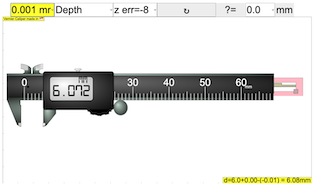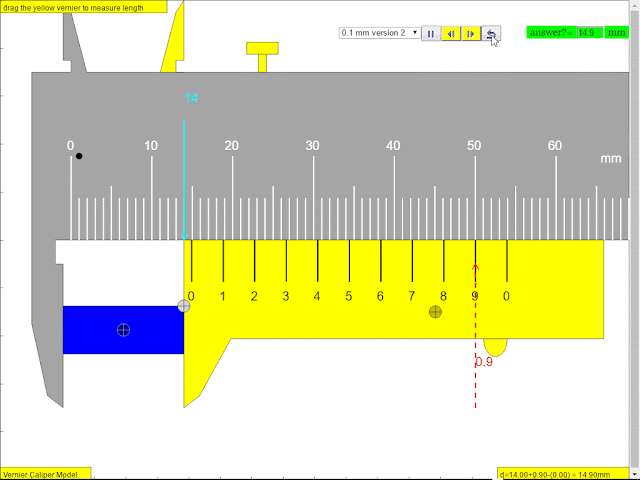https://iwant2study.org/moodle402/mod/laejss/view.php?id=62 Data Analytics version
About
Topics
Measurement of length and timeDescription
Play with the Vernier Caliper Model. Test what you've learned by trying the input field.Vernier calipers can measure internal dimensions (using the uppermost jaws in the picture at right), external dimensions using the pictured lower jaws, and depending on the manufacturer, depth measurements by the use of a probe that is attached to the movable head and slides along the centre of the body. This probe is slender and can get into deep grooves that may prove difficult for other measuring tools.
The vernier scales can be in metric measurements on the upper and lower part of the scale.
Vernier calipers commonly used in industry provide a precision to a hundredth of a millimetre (10 micrometres).
A more precise instrument used for the same purpose is the micrometer
Parts of a vernier caliper:
Outside jaws: used to measure external diameter or width of an object (Blue)Inside jaws: used to measure internal diameter of an object
Depth probe: used to measure depths of an object or a hole ( not shown in this model)
Main scale: gives measurements in mm.
Vernier gives measurements up to one decimal places in mm
Retainer: used to block movable part to allow the easy transferring a measurement ( not shown in this model)
The Vernier calipers model has
an object (Blue) for the internal jaws to measure width of an object with slider to control width of the object and simple drag action to control position of object.
an object (Green) for external jaws to measure internal diameter of a cylinder for example with slider to control dimensions of the cylinder.
a slider for zero error slider
checkbox for hint to scaffold the learners attention and point of focus
checkbox for answer to show the meaning of reading on the main scale and the vernier scale with zero error calculations if any.
drop down menu of the various common vernier scales for sense making and additional testing out by learners their ideas of how vernier works.
fine <> control buttons for learners to manipulate the model with single incremental precision
slider control for fast changes in the vernier measurement
reset button to bring simulaton back to original (default) setting.
Sample Learning Goals
(g) describe how to measure a variety of lengths with appropriate accuracy by means of tapes, rules, micrometers and calipers, using a vernier scale as necessary.Research
arXiv:1408.3803 [pdf]Vernier caliper and micrometer computer models using Easy Java Simulation and its pedagogical design feature-ideas to augment learning with real instruments
Loo Kang Wee, Hwee Tiang Ning
Comments: 8 pages, 8 figures, Physics Education journal
Subjects: Physics Education (physics.ed-ph); Instrumentation and Detectors (physics.ins-det)
https://youtu.be/jHoA5M-_1R4
Video
https://youtu.be/qXtE07tbK8s
Version:
- http://weelookang.blogspot.sg/2015/07/ejss-vernier-caliper-model.html
- http://weelookang.blogspot.sg/2010/06/ejs-open-source-vernier-calipers-java.html
- http://iwant2study.org/lookangejss/01_measurement/ejs/ejs_model_AAPTVernierCaliper.jar
- http://www.opensourcephysics.org/items/detail.cfm?ID=9707
- http://www.phy.ntnu.edu.tw/ntnujava/index.php?topic=684.msg2452#msg2452
- http://www.phy.ntnu.edu.tw/ntnujava/index.php?topic=567.msg2364#msg2364
Vernier Caliper Simulation
Vernier calipers
Vernier calipers can measure internal dimensions (using the
uppermost
jaws in the picture at right), external dimensions using the pictured
lower jaws, and depending on the manufacturer, depth measurements by
the use of a probe that is attached to the movable head and slides
along the centre of the body. This probe is slender and can get into
deep grooves that may prove difficult for other measuring tools.
The vernier scales can be in metric measurements on the upper and lower part of the scale.
Vernier calipers commonly used in industry provide a precision to a
hundredth of a millimetre (10 micrometres).
- Outside jaws: used to measure external diameter or width
of an object (Blue)
- Inside jaws: used to measure internal diameter of an object
- Depth probe: used to measure depths of an object or a hole
( not shown in this model)
- Main scale: gives measurements in mm.
- Vernier gives measurements up to one decimal places in mm
- Retainer: used to block movable part to allow the easy transferring a measurement ( not shown in this model)
The Vernier calipers model has
- an object (Blue) for the internal jaws to measure width of an object with slider to control width of the object and simple drag action to control position of object.
- an object (Green) for external jaws to measure internal diameter of a cylinder for example with slider to control dimensions of the cylinder.
- a slider for zero error slider
- checkbox for hint to scaffold the learners attention and point of focus
- checkbox for answer to show the meaning of reading on the main scale and the vernier scale with zero error calculations if any.
- drop down menu of the various common vernier scales for sense making and additional testing out by learners their ideas of how vernier works.
- fine <> control buttons for learners to manipulate the model with single incremental precision
- slider control for fast changes in the vernier measurement
- reset button to bring simulaton back to original (default)
setting.
Credits:
The Vernier calipers model was created by created by Fu-Kwun Hwang, customized by Loo Kang Wee and Wolfgang Christian using the Easy Java Simulations (EJS) version 4.2 authoring and modeling tool. An applet version of this model is available on the NTNU website < http://www.phy.ntnu.edu.tw/ntnujava/ >.
You can examine and modify this compiled EJS model if you run the model (double click on the model's jar file), right-click within a plot, and select "Open EJS Model" from the pop-up menu. You must, of course, have EJS installed on your computer. Information about EJS is available at: <http://www.um.es/fem/Ejs/> and in the OSP comPADRE collection <http://www.compadre.org/OSP/>.
Translations
| Code | Language | Translator | Run | |
|---|---|---|---|---|
 |
||||
Credits

 Fu-Kwun Hwang; lookang
Fu-Kwun Hwang; lookang
Check out Vernier Caliper tape 150mm measures in mm and inch Digital Ruler LCD battery included. Get it on Shopee now! https://shope.ee/2flTsKNmFN?share_channel_code=1
- more worksheet:
 Physics_lab_Sharjah_
Physics_lab_Sharjah_University_Tahani_Alsarayreh - Worksheet 📖 ejss_model_Micrometer02 Tahani Ibrahim Ragheb AL Sarayreh physics department :Sharjah University : UAE measurment of density.docx 06 June 2020
- Worksheet 📖 ejss_model_Micrometer02 Tahani Ibrahim Ragheb AL Sarayreh physics department :Sharjah University : UAE measurment of density.pdf 06 June 2020
- Worksheet 📖 :ejss_model_Micrometer02_measurments of density 1 Nawal Nayfeh, Physics instructor at university of sharjah, UAE.pdf 25 May 2020
- Worksheet 📖 :ejss_model_Micrometer02_measurments of density 1 Nawal Nayfeh, Physics instructor at university of sharjah, UAE.docx 20 May 2020
Learnng Objectives https://sites.google.com/moe.edu.sg/a-level-physics-tlg/foundations-of-physics
Errors, uncertainties, precision and accuracy through practical work
Learning Outcomes:
-
H2: 1(f), 1(g)
Curriculum Emphasis:
-
Ways of Thinking and Doing
Can uncertainty be reduced or even eliminated? How do measurement uncertainties propagate to derived quantities?
Identify and discuss how errors and uncertainties arise in specific measurements and experiments that students carry out, and discuss ways to reduce the errors and uncertainties. It is also possible to discuss the concepts of precision and accuracy using the data collected.
This is a way of building on existing practical work throughout the year to reinforce students' understanding of error and uncertainty through experiential learning.
Resources:
Apps
Pro
https://play.google.com/store/apps/details?id=com.ionicframework.vernierpro698620
Free
https://play.google.com/store/apps/details?id=com.ionicframework.vernierapp777926
Title: Unveiling the Digital Vernier Caliper: A Quantum Leap in Physics Education
 |
| https://sg.iwant2study.org/ospsg/index.php/1187-aaptverniercalipermmdigitalversion direct link |
 |
| https://sg.iwant2study.org/ospsg/index.php/1187-aaptverniercalipermmdigitalversion direct link |
Introduction:
In the dynamic realm of physics education, where precision and accuracy are paramount, the digital vernier caliper emerges as a revolutionary tool. This advanced instrument seamlessly marries the traditional precision of mechanical calipers with the digital age, providing an unparalleled experience for both educators and students. Let's delve into the features and benefits that make the digital vernier caliper an indispensable asset in the realm of physics education.
Precision Redefined:
The digital vernier caliper represents a quantum leap in precision measurement. With its digital readout, students can obtain measurements with an accuracy that surpasses traditional vernier calipers. The device's ability to display measurements in metric mm units enhances its versatility, catering to a broader spectrum of educational contexts. there is also the option to display the reading in 0.00 mm (teaching precision) or 0.000 mm (reading precision), of which both are acceptable.
Ease of Use:
Designed with user-friendliness in mind, the digital vernier caliper simplifies the measurement process for students. The clear digital display eliminates the need for meticulous manual reading, reducing the chances of human error. This not only accelerates the measurement process but also allows students to focus on understanding the underlying physics concepts rather than struggling with instrument intricacies.
Versatility in Measurement:
Beyond its fundamental role in length measurement, the digital vernier caliper extends its utility to various physics experiments. Its ability to measure internal and external dimensions, as well as depth, widens the scope of experiments that educators can incorporate into their teaching modules. This versatility encourages a hands-on approach to learning, fostering a deeper understanding of measurement principles.
 |
| external dimensions https://sg.iwant2study.org/ospsg/index.php/1187-aaptverniercalipermmdigitalversion direct link |
 |
| internal dimensions https://sg.iwant2study.org/ospsg/index.php/1187-aaptverniercalipermmdigitalversion direct link |
 |
| depth dimensions https://sg.iwant2study.org/ospsg/index.php/1187-aaptverniercalipermmdigitalversion direct link |
Integration with Technology:
Digital Readouts for Instantaneous Precision:
Digital vernier calipers have replaced manual scale readings with digital displays, providing instantaneous and accurate measurements. This integration eliminates the potential for human error in interpreting vernier scale divisions, allowing students to focus on the measured value rather than intricate scale readings. The non zero error continued to be introduced as a pedagogical option as it may be likely to be still a testable feature.
 |
| https://sg.iwant2study.org/ospsg/index.php/1187-aaptverniercalipermmdigitalversion direct link |
Effortless Data Logging and Analysis:
The digital nature of these calipers facilitates easy integration with external devices. Many modern digital vernier calipers come equipped with USB or Bluetooth connectivity, enabling seamless data transfer to computers or tablets. This feature is particularly valuable for educators and students, allowing for effortless data logging and in-depth analysis of measurements. This is unavailable feature on the simulation.
Enhanced Teaching Modules:
The integration of digital vernier calipers with technology opens the door to a myriad of interactive teaching possibilities. Educators can incorporate real-time measurement demonstrations into presentations, making abstract concepts tangible for students. The ability to record and share data also promotes collaborative learning and facilitates discussions around experimental results.
Preparation for Future Technological Landscapes:
By using digital vernier calipers, students are not only honing their measurement skills but also gaining exposure to technology integration. This aligns with the broader goal of preparing students for careers and scientific endeavors that heavily rely on digital tools and data analysis. Familiarity with these instruments during education fosters adaptability in future technological landscapes.
Customization and Unit Conversion:
Digital vernier calipers often come with features that allow users to customize settings, including unit conversions. This adaptability is crucial in physics education, where different units may be employed for various experiments. The ability to switch effortlessly between units say 0.000 to 0.00 enhances the versatility of these tools in a classroom setting.
 |
| https://sg.iwant2study.org/ospsg/index.php/1187-aaptverniercalipermmdigitalversion direct link |
Real-world Applications:
The digital vernier caliper bridges the gap between classroom theory and real-world applications. Its accuracy and versatility make it an ideal tool for physics experiments mirroring professional research and industry practices. Students gain practical experience that goes beyond theoretical knowledge, preparing them for careers in physics and related fields.
Conclusion:
As we embrace the digital age, the digital vernier caliper emerges as a beacon of progress in physics education. Its precision, ease of use, versatility, integration with technology, and real-world applications collectively contribute to a transformative learning experience. By incorporating this advanced tool into physics classrooms, educators empower students to explore the intricate world of measurements with confidence and curiosity, laying the foundation for a new era of scientific inquiry.
How to Use
General Description
This JavaScript App simulates the Vernier Caliper. The simulation shows the instrument setup with a rectangular object .
The Vernier calipers model has an object (Blue) for the internal jaws to measure width of an object with slider to control width of the object and simple drag action to control position of object.
An object (Green) for external jaws to measure internal diameter of a cylinder for example with slider to control dimensions of the cylinder.
Visual Elements
- Outside jaws: used to measure external diameter or width of an object (Blue)
- Inside jaws: used to measure internal diameter of an object
- Depth probe: used to measure depths of an object or a hole ( not shown in this model) .
- Main scale: gives measurements in mm.
- Vernier gives measurements up to one decimal places in mm
- Retainer: used to block movable part to allow the easy transferring a measurement ( not shown in this model)
- fine control buttons for learners to manipulate the model with single incremental precision control
- Vernier gives measurements up to one decimal places in mm
Controls
- ComboBox 1: Sets the type of caliper scales.
- ComboBox 2: Show and hide hints, answers, common objects etc
- ComboBox 3: Sets the zero error
- play button to run the caliper to move automatically.
- reset button to bring simulaton back to original (default) setting.
- ?= click to toggle between combobox or input field.
- combobox/inputfield to ease selecting answers like 0.00 and key in numbers.
- cm/mm text click to toggle between the 2 units, centimeter and millimeter
iCTLT2016 ePosterGuide Example
{/source}
Video iCTLT2016 Sample of ePoster by lookang lawrence wee
Worksheet
- more worksheets:
 Physics_lab_Sharjah_
Physics_lab_Sharjah_University_Tahani_Alsarayreh - Worksheet 📖 ejss_model_Micrometer02 Tahani Ibrahim Ragheb AL Sarayreh physics department :Sharjah University : UAE measurment of density.docx 06 June 2020
- Worksheet 📖 ejss_model_Micrometer02 Tahani Ibrahim Ragheb AL Sarayreh physics department :Sharjah University : UAE measurment of density.pdf 06 June 2020
- Worksheet 📖 :ejss_model_Micrometer02_measurments of density 1 Nawal Nayfeh, Physics instructor at university of sharjah, UAE.pdf 25 May 2020
- Worksheet 📖 :ejss_model_Micrometer02_measurments of density 1 Nawal Nayfeh, Physics instructor at university of sharjah, UAE.docx 20 May 2020
Video
https://youtu.be/VfFVjS2jc00 by Evan
https://www.youtube.com/watch?v=JsBHciYPMJI
GIF
Version:
- https://weelookang.blogspot.com/2024/01/unveiling-digital-vernier-caliper.html digital version with 0.000 and 0.00 mm features
- http://weelookang.blogspot.com/2018/09/vernier-caliper-javascript-html5-applet.html added external, internal and depth measurements by Fu-Kwun Hwang and lookang
- http://weelookang.blogspot.sg/2015/07/ejss-vernier-caliper-model.html by Fu-Kwun Hwang and lookang JavaScript version blogpost
- http://weelookang.blogspot.sg/2010/06/ejs-open-source-vernier-calipers-java.html by Fu-Kwun Hwang and lookang Java version blogpost
- http://iwant2study.org/lookangejss/01_measurement/ejs/ejs_model_AAPTVernierCaliper.jar by Fu-Kwun Hwang and lookang OSP@SG digital library copy
- http://www.opensourcephysics.org/items/detail.cfm?ID=9707 by Fu-Kwun Hwang and lookang first Open Source Physics catalog item
- http://www.phy.ntnu.edu.tw/ntnujava/index.php?topic=1408.0 by Fu-Kwun Hwang with different measure jaws options
- http://www.phy.ntnu.edu.tw/ntnujava/index.php?topic=684.0 by Fu-Kwun Hwang and lookang remix Java version
- http://www.phy.ntnu.edu.tw/ntnujava/index.php?topic=567.0 by Fu-Kwun Hwang with zero errors
Other Resources
- http://physci.kennesaw.edu/html5/tm-vernier.html by Taha Mzoughi
- https://3dwarehouse.sketchup.com/model.html?id=8d9c6f18404cb75dc918062ff9c5ac49
- https://www.geogebra.org/m/jybrnwgp By Seng kwang
Developer notes
Simulation completed on 4 Nov:
1. Vernier Caliper
- enlarged the dragme objects on the bottom scale (yellow) and bottom object (blue) to help make the dragging easier on smaller mobile screen
- added "mm" on top scale
- added checkAndroid for fullscreen
- removed bug for initial tail values (yellow) when measuring depth. (so that yellow tail won't "pierce" through the pink container.
end faq
- Details
- Parent Category: 01 Foundations of Physics
- Category: 01 Measurements
- Hits: 6501










